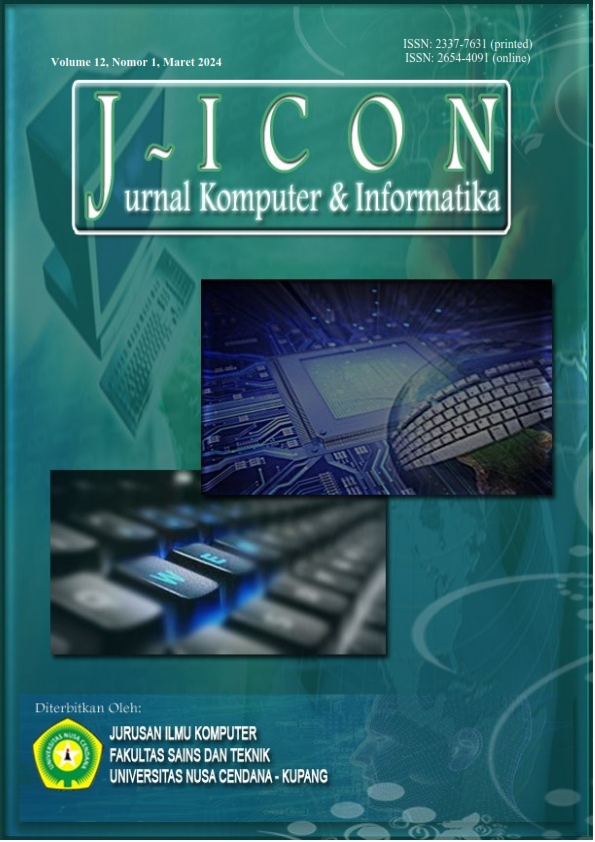APPLICATION OF DATA MINING IN UNDERSTANDING MEDICINE PURCHASE TRANSACTION PATTERNS USING THE APRIORI ALGORITHM AT THE KHARISMA FARMA TIGA PHARMACY
Abstract
Drug storage at the Kharisma Farma Tiga Pharmacy is grouped based on class and form of availability, for categories namely patented, external, over-the-counter, herbal, generic and syrup drugs while for forms of availability, namely drugs in the form of bottles, syrups, creams, capsules, ointments, injection fluids, solutions, roll on and drip. Grouping of drugs based on class and availability in alphabetical order. However, there is a problem when several customers come to the pharmacy at the same time to buy various types of medicines based on different classes or availability of medicines, resulting in a lack of time efficiency in service, pharmacy staff need additional time to search for medicines in their storage place. Seeing that the storage of medicines at the Kharisma Farma Tiga pharmacy is still sorted alphabetically based on class and availability, we need an application that can help recommend arranging the layout of medicine storage by reading customer drug purchase transaction patterns at the Kharisma Farma Tiga Pharmacy so that the storage process medicines according to medicines that are often purchased simultaneously and can increase time efficiency in better customer service, especially in searching for medicines. The application of data mining to determine drug purchasing patterns using the Apriori algorithm at the Kharisma Farma Tiga Pharmacy was built on a web basis. The results obtained in this research are that the application of an a priori algorithm to determine the pattern of drug purchase transactions at the Kharisma Farma Tiga pharmacy has been successfully carried out and can provide recommendations for the layout of drugs that are often purchased based on drug purchases, as for the association rules obtained with a minimum support of 20% and confidence. 75%, namely 2 item sets with 4 rules and 3 item sets with 7 rules. The highest confidence value in the 2 item set is if the consumer buys 60 ml GPU oil then buys 10 ml of capax wind oil, while in the 3 item set is if the consumer buys redoxon effervescent 20s, 60 ml GPU oil then buys 10 ml of capax wind oil.
Downloads
References
G. Y. Andri and Djuariah, “Bentuk Badan Usaha Apotek Ditinjau dari Hukum Perusahaan,” Hukum Responsif, vol. 12, no. 2, pp. 81-93, 2021, doi: http://dx.doi.org/10.33603/responsif.v12i2.5876.
A. Mukaddas and M. Sulaiman Zubair, “Apotek Pendidikan Tadulako: Implementasi Pharmaceutical Care Secara Profesional pada Lingkup Farmasi Komunitas,” vol. 24, no. 4, pp. 865-869, 2019, doi: http://dx.doi.org/10.24114/jpkm.v24i4.11984
A. N. Rahmi and Y. A. Mikola, “Implementasi Algoritma Apriori untuk Menentukan Pola Pembelian Pada Customer (Studi Kasus : Toko Bakoel Sembako),” Information System Journal, vol. 4, no. 1, pp. 14-19, 2021, doi: https://doi.org/10.24076/infosjournal.2021v4i1.561.
H. Kusumo, E. Sediyono, and M. Marwata, “Analisis Algoritma Apriori untuk Mendukung Strategi Promosi Perguruan Tinggi,” Walisongo Journal of Information Technology, vol. 1, no. 1, pp. 49, 2019, doi: https://doi.org/10.21580/wjit.2019.1.1.4000.
V. N. Lafifah, M. T. Furqon, and N. Santoso, ‘Implementasi Algoritme Modified-Apriori Untuk Menentukan Pola Penjualan Sebagai Strategi Penempatan Barang Dan Promo’, Jurnal Pengembangan Teknologi Informasi Dan Ilmu Komputer, vol. 2, no. 10, pp. 3829–3834, 2018. [Online]. Available: https://j-ptiik.ub.ac.id/index.php/j-ptiik/article/view/2764. [Accessed 17 Februari. 2024]
E. Alma, E. Utami, and F. Wahyu Wibowo, “Implementasi Algoritma Apriori untuk Rekomendasi Produk pada Toko Online,” Citec Journal, vol. 7, no. 1, pp. 63-74, 2020, doi: https://doi.org/10.24076/citec.2020v7i1.241.
P. Mai, S. Tarigan, J. T. Hardinata, H. Qurniawan, M. Safii, and R. Winanjaya, “Implementasi Data Mining Menggunakan Algoritma Apriori Dalam Menentukan Persediaan Barang (Studi Kasus : Toko Sinar Harahap),” Jurnal Janitra Informatika dan Sistem Informasi, vol. 12, no. 2, pp. 51–61, 2022, doi: https://doi.org/10.24853/justit.12.2.%25p.
Saefudin and S. DN, “Penerapan Data Mining dengan Metode Algoritma Apriori untuk Menentukan Pola Pembelian Ikan’,” Jurnal Sistem Informasi, vol. 6, no. 2, pp. 110–114, 2019, doi: https://doi.org/10.30656/jsii.v6i2.1587.
A. Prahendratno et al., Business Intelegent (Pengantar Business Intelligence dalam Bisnis). Jambi: PT. Sonpedia Publishing Indonesia, 2023.
C. Leto, D. Sujana, V. S. Windyasari, and M. Ridwan, Konsep Data Mining dan Penerapan, 1st ed, vol. 1. Bandar Lampung: CV. Keranjang Teknologi Media, 2023.
R. F. Putra et al., Data Mining: Algoritma dan Penerapan. Jambi: PT. Sonpedia Publishing Indonesia, 2023.
N. Fitrianti Fahrudin, “Penerapan Algoritma Apriori untuk Market Basket Analysis,” MIND Journal, vol. 4, no. 1, pp. 13-22, 2019, doi: https://doi.org/10.26760/mindjournal.v4i1.13-23.
N. Merliani Nurisya, N. Khoerida Isnaeni, N. Widiawati Tri, L. Triana Adi, and P. Subarkah, “Penerapan Algoritma Apriori Pada Transaksi Penjualan Untuk Rekomendasi Menu Makanan dan Minuman,” Jurnal Nasional Teknologi dan Sistem Informasi, vol. 8, no. 1, pp. 009–016, 2022, doi: http://dx.doi.org/10.25077/TEKNOSI.v8i1.2022.9-16.
P. N. Harahap and S. Sulindawaty, “Implementasi Data Mining Dalam Memprediksi Transaksi Penjualan Menggunakan Algoritma Apriori (Studi Kasus PT.Arma Anugerah Abadi Cabang Sei Rampah),” MATICS, vol. 11, no. 2, pp. 46, 2020, doi: https://doi.org/10.18860/mat.v11i2.7821.
P. W. Rahayu and I. N. Bernadus, “Penerapan Metode Single Exponential Smoothing Pada Peramalan Penerimaan Siswa Baru,” Jurnal Ilmu Komputer dan Bisnis, vol. 12, no. 2a, pp. 122–127, 2021, doi: https://doi.org/10.47927/jikb.v12i2a.204.
Copyright (c) 2024 Prastyadi Wibawa Rahayu, I Nyoman Bernadus, Aulia Iefan Datya

This work is licensed under a Creative Commons Attribution 4.0 International License.
The author submitting the manuscript must understand and agree that if accepted for publication, authors retain copyright and grant the journal right of first publication with the work simultaneously licensed under a Creative Commons Attribution (CC-BY) 4.0 License that allows others to share the work with an acknowledgment of the work’s authorship and initial publication in this journal.
 Prastyadi Wibawa Rahayu(1*)
Prastyadi Wibawa Rahayu(1*)




